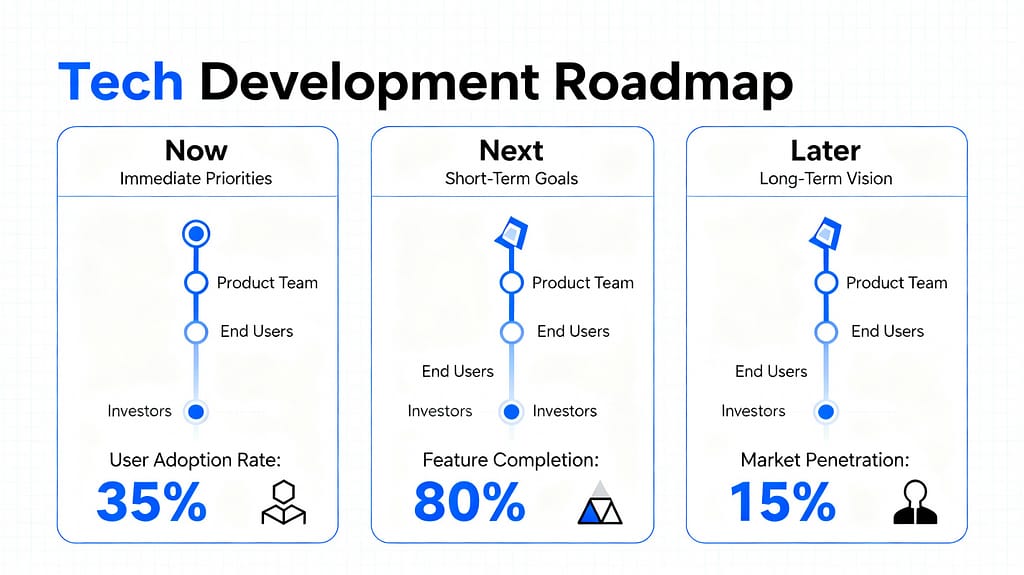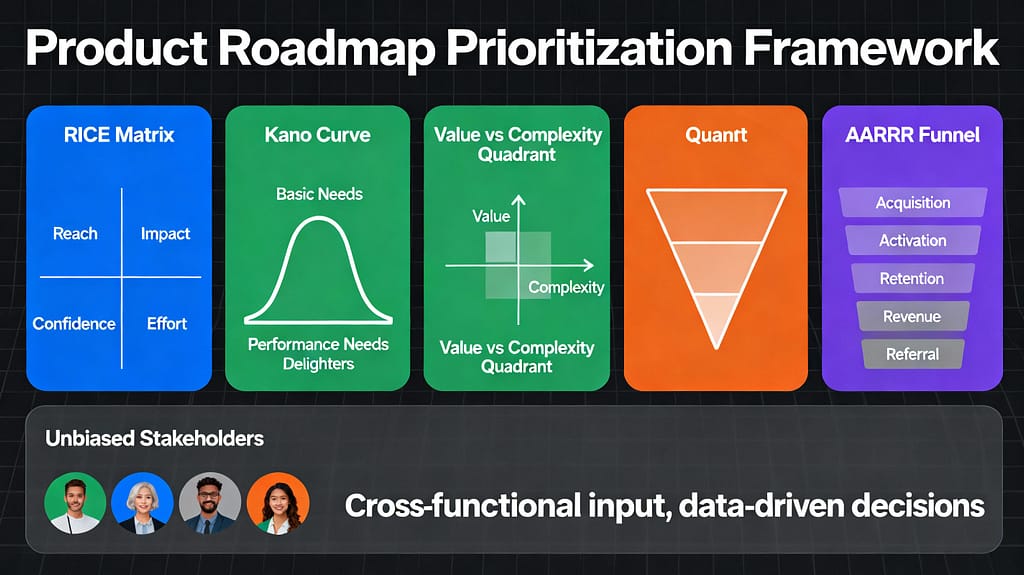
A strong product roadmap isn’t a decoration for slide decks—it’s an operational weapon. It forces clarity, sets expectations, aligns teams, and defines the sequence of value delivery. Weak roadmaps create chaos: misaligned teams, unrealistic commitments, and reactive decision-making. Strong roadmaps do the opposite—they provide focus and narrative consistency.
This guide breaks down how to build a roadmap that is execution-ready, strategically grounded, and actually used by stakeholders.
Table of Contents
What Is a Product Roadmap (and What It’s Not)
A roadmap is a strategic communication tool that outlines how you plan to achieve product outcomes over time. It is not:
- a feature backlog
- a promise to customers
- a Gantt chart
- a wishlist from executives
Think of the roadmap as a sequence of problems worth solving, backed by data and timed for maximum impact.
Start With the Product Strategy (Roadmaps Cannot Stand Alone)
A roadmap only makes sense when it is a translation of product strategy. Without a clear strategy—your target customer, the problem space, and the business model—the roadmap collapses into random tasks.
Your roadmap should always reference:
- North Star Metric
- Key input metrics
- Company goals / OKRs
- Customer segments and JTBD (Jobs-To-Be-Done)
If these aren’t clear, fix them before touching the roadmap.
For deeper structure on prioritization, see tools like the RICE Scoring Calculator on your site—useful when scoring roadmap items for reach, impact, confidence, and effort:
https://shubhamnayak.com/rice-scoring-calculator/
Define Clear Outcomes Before Listing Features
The worst roadmaps are service lists. The best roadmaps are outcome-guided.
Example difference:
❌ “Add login with Google, redesign homepage, add dark mode.”
✔️ “Improve activation rate for new B2C users by 15%.”
Outcome-first thinking forces you to focus on what must change in user behavior.
Common outcome categories:
- Activation (conversion to core action)
- Retention (repeat usage)
- Efficiency (reduce cost or operational load)
- Monetization (increase ARPU or self-serve conversion)
- Expansion (new markets, platforms, personas)
Prioritize With a Framework (Avoid Political Roadmaps)

Stakeholders will always push for their own agendas—sales wants deal closers, marketing wants shiny features, engineering wants tech debt cleanup. Frameworks minimize bias and bring objectivity.
Widely used scoring systems include:
- RICE (Reach, Impact, Confidence, Effort)
- Kano Model (Delighters vs. Must-haves vs. Dissatisfiers)
- Value vs. Complexity
- AARRR Metrics Alignment (Acquisition, Activation, Retention, Revenue, Referral)
A practical process:
- Identify problems worth solving.
- Score opportunities using RICE for prioritization.
- Validate with user feedback or data.
- Re-score once engineering estimates come in.
This forces disciplined thinking and reduces emotional decision-making.
Build a Three-Horizon Roadmap (Clear, Scannable, Practical)
High-performing PMs avoid exact dates except for items already in execution. The best structure is a three-horizon roadmap:
1. Now (0–3 months): Execution commitments
These are validated, groomed, and in engineering pipeline.
Characteristics: high clarity, defined problem, estimated.
2. Next (3–9 months): Strategic bets
These are validated but not yet committed.
Characteristics: medium clarity, some assumptions, early designs.
3. Later (9–18 months): Directional opportunities
These are hypothesis-level opportunities.
Characteristics: low clarity, no commitment.
This structure gives predictability without sacrificing flexibility.
Turn Problems Into Themes (Themes Reduce Chaos)
Themes group related roadmap items under a single meaningful outcome. They make your roadmap easier to understand and defend.
Examples of strong themes:
- Reduce onboarding friction for SMB merchants
- Improve power-user workflows for advanced editors
- Expand mobile capabilities for field teams
Themes help stakeholders understand why something matters instead of getting stuck arguing about which feature goes where.
To explore other product-specific knowledge structures, browse the general blog section for related PM concepts:
https://shubhamnayak.com/blog/
Make Roadmaps Cross-Functional (Not Just a PM Document)
A roadmap is useless unless engineering, design, marketing, sales, support, and leadership understand and believe in it.
To make the roadmap cross-functional:
- Clarify engineering constraints (tech debt, infra work, platform limitations)
- Configure themes with input from sales and support based on customer insights
- Include marketing on large feature launches
- Get data science alignment for measurement feasibility
The roadmap becomes credible when all teams understand the trade-offs.
Include Metrics for Every Roadmap Item (No Metrics = No Clarity)
Every initiative must have measurable outcomes. Examples:
- Improve activation → % new users completing core action in 7 days
- Reduce churn → % customers canceling in 90 days
- Increase revenue → ARPU, conversion rate, expansion revenue
- Improve efficiency → manual hours saved per workflow
Metrics create a feedback loop between roadmap and reality.
Communicate the Roadmap Like a Narrative
A roadmap is a story:
Here is the core problem. Here is the data. Here is what we’re doing. Here is the expected impact.
Good PMs don’t dump spreadsheets. They articulate why the sequence matters.
Strong narrative communication includes:
- The change you’re trying to drive
- The reasoning behind prioritization
- Dependencies and engineering constraints
- Expected impact on key metrics
- Clear acknowledgment of uncertainties
This reduces friction and aligns expectations.
Review and Update Roadmaps Regularly
Roadmaps must evolve as new data emerges.
Recommended cadence:
- Monthly: Tactical updates with engineering
- Quarterly: Strategic review with leadership
- Continuous: Re-scoring priorities as new insights appear
A roadmap that doesn’t evolve is a roadmap disconnected from reality.
For ongoing PM improvement, browse curated resources:
https://shubhamnayak.com/resources/
Example Roadmap Theme Breakdown (SaaS Example)
Let’s take a B2B SaaS product struggling with activation and retention.
Theme: Reduce Onboarding Drop-off (Now)
- Build checklist-based onboarding
- Add guided walkthrough
- Improve error messaging for integrations
Expected impact: +12% Week-1 activation
Theme: Deepen Collaboration Tools (Next)
- Real-time co-editing
- Permissions revamp
- Shared dashboards
Expected impact: +8% retention for team accounts
Theme: Mobile Expansion (Later)
- Offline mode
- Push notification workflows
- Role-based mobile dashboards
Expected impact: Expanded TAM + better field usage
This illustrates outcome-led planning, not task-led planning.
Conclusion
A winning product roadmap is grounded in strategy, driven by outcomes, and organized around themes. It balances flexibility with clarity and aligns teams by making trade-offs explicit. Roadmaps fail when they are feature lists or executive wishlists; they succeed when they are metric-driven, cross-functional, and continuously validated.
Roadmaps are living systems. Treat them as such.